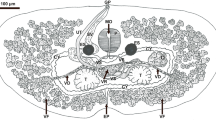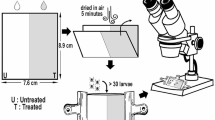Abstract
In the present study, the life cycle of Tunga penetrans was established in Wistar rats in the laboratory, and the morphology of the resulting developmental stages was studied by means of light and scanning electron microscopy. It was seen that the females enter at a nonfertilized stage through the skin of their hosts. Only there the copulation occurs, while females and males brought together in a Petri dish showed no interest in each other. In any way—fertilized or not—the females start about 6 days after penetration and hypertrophy with the ejection of eggs. While fertilized eggs proceed to development, the unfertilized ones remain arrested. The eggs are ovoid and measure about 600 × 320 μm. The larvae hatch from the eggs 1–6 days (mean 3–4) after ejection. Formation of larvae 2 took at least another day, while 4 up to 10 days more were needed until this larva starts pupation (mean 5–7 days). The formation of the adult fleas inside the puparium occurred within 9–15 days (with a maximum hatch at day 12). Adult female fleas having reached the skin of a host start blood sucking within 5 min and prepare to enter the skin. After 24 h, the flea stacked already with two thirds of its body inside the skin. After 40 h, the penetration was completed, and feeding and hypertrophical enlargement started, which was completed on day 6, when eggs became ejected. When studying the morphology of the fleas obtained from different hosts, slight variations were seen, which, however, are not significant for a species separation but may be an indication of the presence of different strains/races or the beginning of such a formation.
















Similar content being viewed by others
References
Achtman M, Morelli G, Zhu P, Wirth T, Diehl I, Kusecek B, Vogler AJ, Wagner DM, Allender CJ, Easterday WR, Chenal-Francisque V, Worsham P, Thomson NR, Parkhill J, Lindler LE, Carniel E, Keim P (2004) Microevolution and history of the plague bacillus Yersinia pestis. Proc Natl Acad Sci USA 101:17837–17842
Blair PJ, Jiang J, Schoeler GB, Moron C, Anaya E, Cespedes M, Cruz C, Felices V, Guevara C, Mendoza L, Villaseca P, Sumner JW, Richards AL, Olson JG (2004) Characterization of spotted fever group rickettsiae in flea and tick specimens from Northern Peru. J Clin Microbiol 42:4961–4967
Connor DH (1976) Diseases caused by arthropods: tungiasis. In: Binford CH, Connor DH (eds) Pathology of tropical and extraordinary diseases. Armed Forces Institute of Pathology, Washington, DC, pp 610–614
Eisele M, Heukelbach J, Van Marck E, Mehlhorn H, Meckes O, Franck S, Feldmeier H (2003) Investigations on the biology, epidemiology, pathology and control of Tunga penetrans in Brazil: I. Natural history of tungiasis in man. Parasitol Res 90:87–99
Feldmeier H, Heukelbach J, Eisele M, Queiroz Sousa A, Marilac Meireles Barbosa L, Carvalho CBM (2002) Bacterial superinfection in human tungiasis. Trop Med Int Health 7:559–564
Feldmeier H, Eisele M, Saboia-Moura RC, Heukelbach J (2003) Severe tungiasis in underprivileged communities: a case series from Brazil. Emerg Infect Dis 9:949–955
Geigy R, Herbig A (1949) Die Hypertrophie der Organe beim Weibchen von Tunga penetrans. Acta Trop 6:246–262
Geigy R, Suter P (1958) Zur Kopulation der Flöhe. Report Schweizerisches Tropeninstitut, Basel. P. pp 150–160
Greco JB, Sacramento E, Tavares-Neto J (2001) Chronic ulcers and myiasis as ports of entry for Clostridium tetani. Braz J Infect Dis 5:319–323
Heukelbach J, Araújo Sales de Oliveira F, Hesse G, Feldmeier H (2001) Tungiasis: a neglected health problem of poor communities. Trop Med Int Health 6:267–272
Heukelbach J, Costa AML, Wilcke T, Mencke N, Feldmeier H (2004) The animal reservoir of Tunga penetrans in severely affected communities of North-East Brazil. Med Vet Entomol 18:329–335
Hicks EP (1930) The early stages of the jigger flea, Tunga penetrans. Ann Trop Med Parasitol 24:575–586
Lane RP, Crosskey RW (eds) (1993) Medical insects and arachnids. Chapman and Hall, London
Lewis RE (1998) Résumé of the Siphonaptera (Insecta) of the World. J Med Entomol 35:377–389
Linardi PM, Guimaráes LR (2000) Sifonapteros do Brasil. FAPESP 1. pp 157–181
Mehlhorn H, Eichenlaub D, Löscher T, Peters W (1995) Diagnostik und Therapie der Parasitosen des Menschen, 2nd edn. Gustav Fischer, Stuttgart, pp 328–337
Muehlen M, Heukelbach J, Wilcke T, Winter B, Mehlhorn H, Feldmeier H (2003) Investigations on the biology, epidemiology, pathology and control of Tunga penetrans in Brazil. Parasitol Res 90:449–455
Nagy N, D’Haese J, Heukelbach J, Mencke N, Feldmeier H, Mehlhorn H (2007) Molecular biological comparison of jigger fleas from different hosts. Parasitol Res (in press)
Njeumi F, Nsangou C, Ndjend AG, Koga Ostanello F, Pampiglione S (2002) Tunga penetrans. au Cameroun. Rev Med Vet 153:176–180
Pampiglione S, Trentini M, Fioravanti ML, Onore G, Rivasi F (2002) A new species of Tunga (Insecta, Siphonaptera) in Ecuador. Parassitologia 44:127
Pampiglione S, Trentini M, Fioravanti ML, Onore G, Rivasi F (2003) Additional description of a new species of Tunga (Siphonaptera) from Ecuador. Parasite 10:9–15
Pampiglione S, Trentini M, Fioravanti ML, Gustinelli A (2004) Differential diagnosis between Tunga penetrans (L., 1758) and T. trimamillata Pampiglione et al., 2002 (Insecta, Siphonaptera), the two species of the genus Tunga parasitic in man. Parasite 11:51–57
Titball RW, Hill J, Lawton DG, Brown KA (2003) Yersinia pestis. and plague. Biochem Soc Trans 31:104–107
Vobis M (2002) Flöhe und ihre molekularbiologische Charakterisierung. Diploma thesis, University of Düsseldorf
Vobis M, D’Haese J, Mehlhorn H, Mencke N (2003) Evidence of horizontal transmission of feline leukemia virus by the cat flea (Ctenocephalides felis). Parasitol Res 91:467–470
Vobis M, D’Haese J, Mehlhorn H, Mencke N, Blagburn BL, Bond R, Denholm I, Dryden MW, Payne P, Rust MK, Schroeder I, Vaughn MB, Bledsoe D (2004) Molecular phylogeny of isolates of Ctenocephalides felis and related species based on analysis of ITS1, ITS2 and mitochondrial 16S rDNA sequences and random binding primers. Parasitol Res 94:219–226
Vobis M, D’Haese J, Mehlhorn H, Heukelbach J, Mencke N, Feldmeier H (2005) Molecular biological investigations of Brazilian Tunga isolates from man, dogs, cats, pigs and rats. Parasitol Res 96:107–112
Vobis M, D’Haese J, Mehlhorn H, Mencke N, Truyen U (2007) Fleas as vectors of calici-virus of cats. Parasitol Res (in press)
Acknowledgments
We are grateful to Prof. Trentini and Prof. Luchetti from the Facoltà Di Medicina Veterinaria in Bologna (Italy) for sending us three specimens of gravid female T. penetrans and three specimens of gravid female T. trimamillata isolated in Ecuador. Furthermore, we thank Valeria Santos (Fortaleza) for her support during the field study in Brazil.
Author information
Authors and Affiliations
Corresponding author
Rights and permissions
About this article
Cite this article
Nagy, N., Abari, E., D’Haese, J. et al. Investigations on the life cycle and morphology of Tunga penetrans in Brazil. Parasitol Res 101 (Suppl 2), 233–242 (2007). https://doi.org/10.1007/s00436-007-0683-8
Published:
Issue Date:
DOI: https://doi.org/10.1007/s00436-007-0683-8




